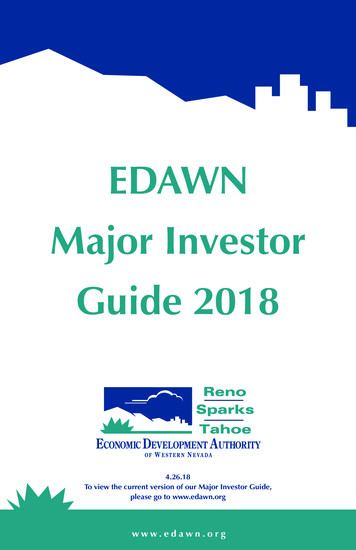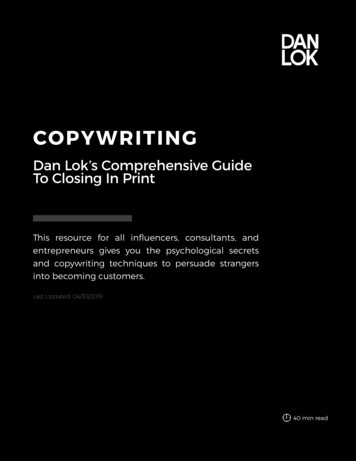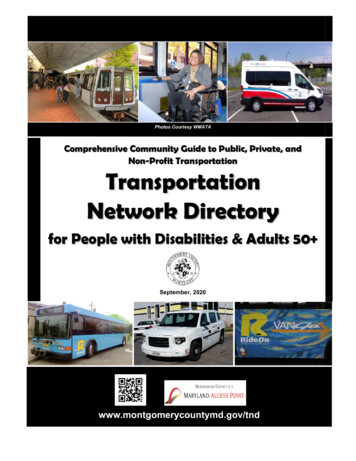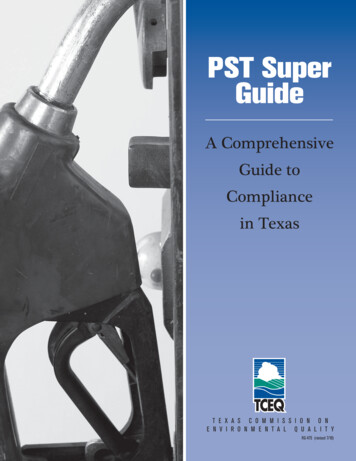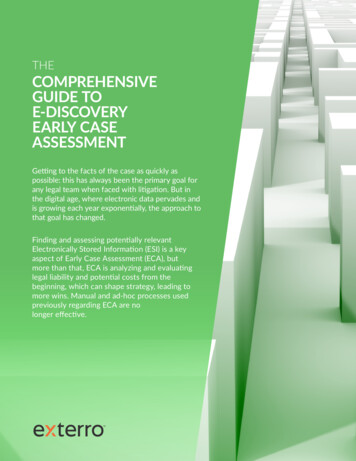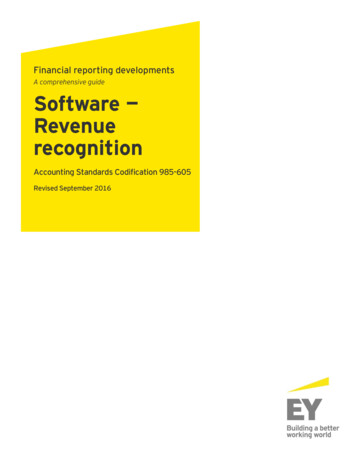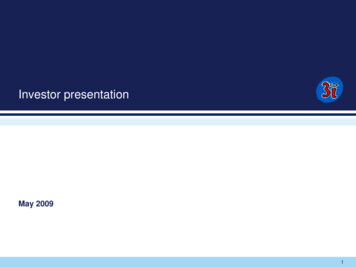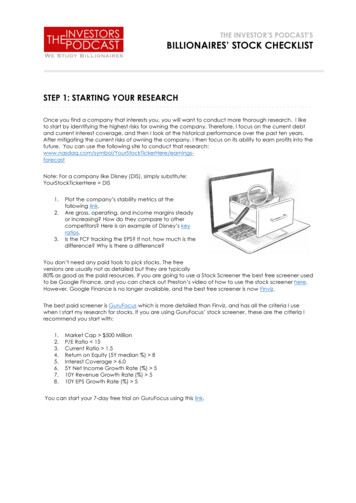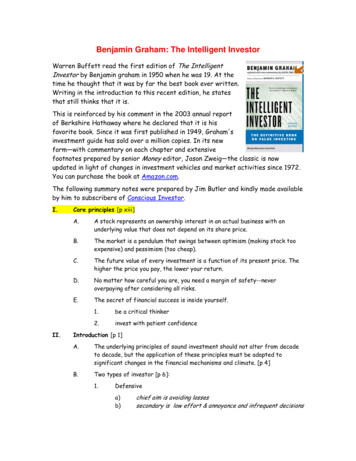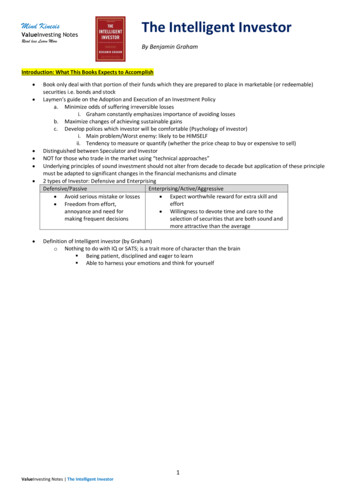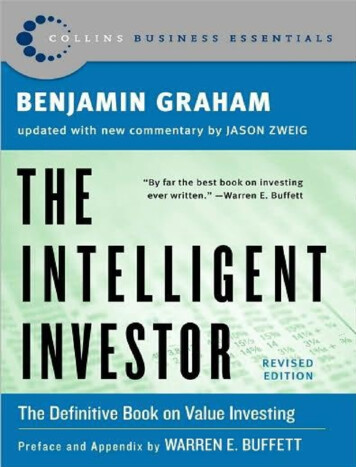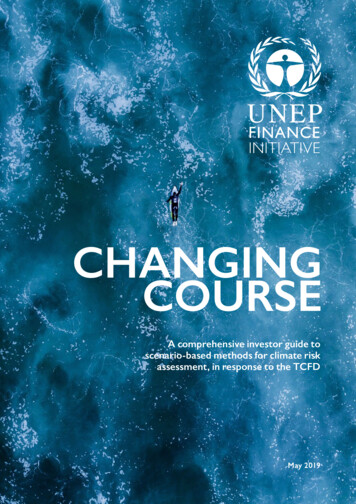
Transcription
A comprehensive investor guide toscenario-based methods for climate riskassessment, in response to the TCFDMay 2019Changing Course 1
Twenty institutional investors from eleven countries, convened by UNEP FI and supportedby Carbon Delta, have worked throughout 2018–2019 to analyse, evaluate, and test, stateof-the-art methodologies to enable 1.5 C, 2 C, and 3 C scenario-based analysis of theirportfolios in line with the recommendations of the FSB’s Task Force on Climate-relatedFinancial Disclosures (TCFD). The outputs and conclusions of this Pilot are capturedin the following report and aim to enhance the understanding and ease adoption of theTCFD recommendations by the wider investment industry.UN Environment – Finance Initiative is apartnership between UN Environmentand the global financial sector created inthe wake of the 1992 Earth Summit witha mission to promote sustainable finance.More than 200 financial institutions,including banks, insurers, and investors,work with UN Environment to understand today’s environmental, social andgovernance challenges, why they matterto finance, and how to actively participate in addressing them.www.unepfi.orgVivid Economics is a strategic consultancy providing our private and publicclients with deep sectoral and thematicexpertise at the nexus of finance,commerce and the environment. For ourfinancial sector clients, we provide policyand market intelligence, scenario modelling, and risk and opportunity assessmenttools that support investment strategy,risk management, investee engagementand financial disclosure.Carbon Delta is a climate change dataanalytics firm that quantifies investmentrisks for more than 30,000 companiesalong numerous climate change scenarios.With our Climate Value-at-Risk (CVaR)model we aim to em power financialinstitutions with the tools necessary toprotect assets from the worst effectsresulting from climate change and alsohelp identify new, innovative low carboninvestment ta.com
CO NTEN TSPerspectives from the pilot membership. 5Foreword by Mark Carney. 7Foreword by Satya Tripathi. 8Acknowledgements. 9Executive Summary.101 Introduction.162 Overview of methodologies.233 Building blocks of the Investor Pilot methodology.384 Comparing Climate Value at Risk across 1.5 C, 2 C and 3 C Worlds.505 Operationalising the methodology: case studies.656 Future directions.116Appendix I.120Appendix II.121Appendix ing Course Contents 1
LIST O F TAB L ESTable 1:Table 2:Table 3:Table 4:Table 5:Table 6:Table 7:Table 8:Table 9:Table 10:Table 11:Table 12:Table 13:Table 14:Table 15:Table 16:Table 17:Table 18:Table 19:Table 20:Table 21:Table 22:Table 23:Table 24:Table 25:Table 26:Table 27:Table 28:Table 29:Table 30:Table 31:Table 32:Table 33:Key innovative elements, gaps and next steps for the Carbon Delta methodology.48Results for the Top 1,200 companies by global market cap.51Sector-level results for Policy Risk illustrate the range of climaterelated impacts across the portfolio.52Sector-level results for Technology Opportunities illustrate the rangeof impacts across the portfolio.53Policy Risk for a Delayed and Non-delayed scenario.53Physical Risk for the average and aggressive climate models andeach specific weather hazard .54Physical Risk for the average scenario by sector and weight.55Top 10 locations exposed to physical risks based on sector and hazard.56Results for the Top 1,200 companies by global market cap.58Sector-level results for Policy Risk illustrate the range of climate-relatedimpacts across the portfolio.58Sector-level results for Technology Opportunities illustrate the range ofimpacts across the portfolio.59Policy risk for a delayed and non-delayed scenario.59Physical Risk for the Average and Aggressive climate models andeach specific weather hazard.60Physical Risk for the average scenario by sector and contribution.60Top 10 locations exposed to Physical Risks based on sector and hazard.61Results for a Coal Portfolio.63Results for a Renewable Energy Portfolio.63CDPQ comparison of sectors through specific value chains.72CDPQ total VaR of cement and iron and steel sectors.73Manulife Canadian equity portfolio results.75Manulife Asian equity portfolio results.75Manulife sector weights for Canadian and Asian equity portfolios.76Manulife total portfolio VaR of these hazards for both portfolios.77Manulife industry ranking by exposure to extreme heat risk.77Manulife industry ranking by exposure to coastal flooding risk.77Manulife industry ranking by exposure to tropical cyclone risk.77Rockefeller portfolio CVaR results comparison.84Investa NGA factors across Australian cities where portfolio is situated.95Investa variance between energy intensity and emissions intensityacross geographical differences.96KLP estimated VaR for cumulative holdings in listed bonds and stocks.100La Française CVaR portfolio analysis – summary results.106La Française CVaR global reference index – summary results.107TDAM results under a 2 C scenario.112Changing Course Contents 2
LIST O F F I GUR ESFigure 1:Figure 2:Figure 3:Figure 4:Figure 5:Figure 6:Figure 7:Figure 8:Figure 9:Figure 10:Figure 11:Figure 12:Figure 13:Figure 14:Figure 15:Figure 16:Figure 17:Figure 18:Figure 19:Figure 20:Figure 21:Figure 22:Figure 23:Figure 24:Figure 25:Figure 26:Figure 27:Figure 28:Figure 29:Figure 30:Figure 31:Figure 32:Analytical elements of scenario-based impact assessments.11The TCFD recommendations are structured around four broad themes.19Analytical elements of scenario-based impact assessments.24Framework for categorisation of Physical Risk impact assessment methodologies.27Overview of Physical Risk assessment methodologies.28Framework for categorisation of Transition Risk impact assessment methodologies.33Overview of Transition Risk assessment methodologies.34The final outputs of the Carbon Delta methodology are quantifiedcosts or revenues and the CVaR.38Carbon Delta assesses climate risk across two main pillars; transitioneffects and physical impacts.39Carbon Delta calculates climate costs and profits over thenext 15 years, then assumes a linear decline.46Schematic display of Carbon Delta’s warming potential calculation.47Anonymous company locations that are exposed to significantlevels of acute physical climate risks.56Portfolio Temperature Gauge for Market Portfolio.57Anonymous company locations that are exposed to significantlevels of acute physical climate risks.61Portfolio Temperature Gauge for Top 1,200 Companies.62Portfolio Temperature Gauge for Coal and Renewable Energy Portfolios.64Global average surface temperature changes relative to 1986-2
by Carbon Delta, have worked throughout 2018–2019 to analyse, evaluate, and test, state-of-the-art methodologies to enable 1.5 C, 2 C, and 3 C scenario-based analysis of their portfolios in line with the recommendations of the FSB’s Task Force on Climate-related Financial Disclosures (TCFD). The outputs and conclusions of this Pilot are captured in the following report and aim to .
